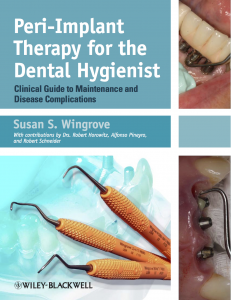
Today, dental professionals need to look at professional maintenance in a whole new light. A paradigm shift in professional maintenance and home-care recommendations for patients with tooth-borne and implant-borne restorations is occurring. I would refer to this as ‘mixed bag’ patients with natural teeth, restorations, and implants. We see these ‘Mixed bag’ patient every day. An additional resource to provide the best maintenance would be The American College of Prosthodontists guidelines for maintenance and recall of healthy patients with tooth- and implant-borne restorations. developed in 2016.1
Biofilm and calculus need to be addressed in every professional maintenance appointment. Biofilm can trigger a pro-inflammatory response to induce a systemic effect that can result in infection and affect the overall health of the patient.2,3
Fortunately, with research, new tests and home-care products have emerged. Identifying acid producing biofilm that can lead to decay, gum recession, and possible corrosion on implants, along with a saliva test for pH is also of concern.
A recent study; Chemical Effects of Stannous and Sodium Fluoride Dentifrices on Ti-Alloy Surfaces was completed. In this study, the effects of acidity in the mouth on Ti-alloy – Implants was evaluated.4 The results showed daily use of fluoride in combination with Ti Implants is safe at a near neutral pH for both Stannous and Sodium Fluoride (FL). An important point, fluoride can affect the oxide layer on the implant surface and make the Ti Implant prone to corrosion at Low pH or High pH in concentration, so be extremely careful selecting a fluoride for your ‘Mixed bag’ patients.
Home-care recommendations for implant patients should include all neutral pH products. Products to recommend should kill bacteria, inhibit plaque metabolism and acid production, the regrowth of plaque for 8 to 12 hours. Brush, floss or use a water flosser and rinse using tools that focus on disrupting the biofilm such as electric toothbrush, FL dentifrice, water flosser and non-alcohol anti-microbial mouth-rinse.1
How to assess Implants clinically –
Start with the Wingrove 5-step Implant Assessment which consists of; visual soft-tissue assessment, probe and palpate for signs of infection. Assess for residue; calculus, cement, or instrument residue using dental tape or woven floss. Check for mobility of the implant and have the dentist check occlusion. Finally assess the bone level to identify the health of the implant with a radiograph.3
Implants are held in by bone, not ligaments. Genetic tests like Celsus One™ or Alert 2™ by OralDNA®, could be used to identify certain inflammatory genotypes that can be more pro-inflammatory and/or susceptible to breakdown of bone, before the bacterial has chance to impact the bone. Biofilm assessments tests like MyPerioPath®, by OralDNA®, show bacterial risk. This test can be used before implant placement and/or with implant maintenance to help determine if the oral cavity bacterial field is healthy and remains healthy.
Shift your professional implant maintenance protocol to the next level.Include assessment for bacteria level, saliva test for pH, and recommend neutral based products for home-care. Educate patients on the need for daily biofilm removal, the need for risk assessments or genetic tests before implant placement and as a part of implant maintenance for healthy implants and total overall health.
References:
- Bidra A., Daubert D., Garcia L., Kosinski T., Nenn C., Olsen J., Platt J.A., Wingrove S., Chandler N.D., Curtis D. 2016 ACP Clinical Practice Guidelines for Recall and Maintenance of Patients with Tooth-Borne and Implant-Borne Dental Restorations. J Prosthodontics 25 (2016) S32-S40.
- Quirynen M, DeSote M, Steeberghe D. Infectious risks for oral implants: a review of the literature. Clin Oral Impl Res 2002; 13:1-19
- Wingrove S. Peri-Implant Therapy for the Dental Hygienist: A Clinical Guide to Implant Maintenance & Disease Complications 2013; Oxford: Wiley Blackwell
- *Suszcynsky-Meister E, Shauchuk A, Hare T, Hunger L, Valent D, Massad J, Wingrove S, St. John S1. Chemical Effects of Stannous & Sodium Fluoride Dental Treatments on Titanium Alloy Surfaces. AADR Annual Conference, Ft Lauderdale, FL, Mar. 2018.
- For more information on how to become an OralDNA Provider – scan HERE:

- Inflammation is Key! - August 12, 2022
- Implants, Biofilm, & pH! - September 21, 2018
